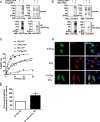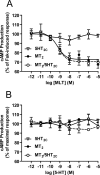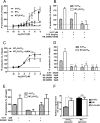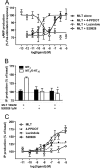Convergence of melatonin and serotonin (5-HT) signaling at MT2/5-HT2C receptor heteromers
- PMID: 25770211
- PMCID: PMC4416857
- DOI: 10.1074/jbc.M114.559542
Convergence of melatonin and serotonin (5-HT) signaling at MT2/5-HT2C receptor heteromers
Abstract
Inasmuch as the neurohormone melatonin is synthetically derived from serotonin (5-HT), a close interrelationship between both has long been suspected. The present study reveals a hitherto unrecognized cross-talk mediated via physical association of melatonin MT2 and 5-HT2C receptors into functional heteromers. This is of particular interest in light of the "synergistic" melatonin agonist/5-HT2C antagonist profile of the novel antidepressant agomelatine. A suite of co-immunoprecipitation, bioluminescence resonance energy transfer, and pharmacological techniques was exploited to demonstrate formation of functional MT2 and 5-HT2C receptor heteromers both in transfected cells and in human cortex and hippocampus. MT2/5-HT2C heteromers amplified the 5-HT-mediated Gq/phospholipase C response and triggered melatonin-induced unidirectional transactivation of the 5-HT2C protomer of MT2/5-HT2C heteromers. Pharmacological studies revealed distinct functional properties for agomelatine, which shows "biased signaling." These observations demonstrate the existence of functionally unique MT2/5-HT2C heteromers and suggest that the antidepressant agomelatine has a distinctive profile at these sites potentially involved in its therapeutic effects on major depression and generalized anxiety disorder. Finally, MT2/5-HT2C heteromers provide a new strategy for the discovery of novel agents for the treatment of psychiatric disorders.
Keywords: Cell Signaling; Depression; G Protein-coupled Receptor (GPCR); GPCR; Heteromerization; Melatonin; Molecular Pharmacology; Serotonin.
© 2015 by The American Society for Biochemistry and Molecular Biology, Inc.
Figures







Similar articles
-
Pharmacological evidence for transactivation within melatonin MT2 and serotonin 5-HT2C receptor heteromers in mouse brain.FASEB J. 2021 Jan;35(1):e21161. doi: 10.1096/fj.202000305R. Epub 2020 Nov 6. FASEB J. 2021. PMID: 33156577
-
Synthesis and pharmacological evaluation of dual ligands for melatonin (MT1/MT2) and serotonin 5-HT2C receptor subtypes (II).Eur J Med Chem. 2015 Jan 27;90:822-33. doi: 10.1016/j.ejmech.2014.12.021. Epub 2014 Dec 13. Eur J Med Chem. 2015. PMID: 25528336
-
The melatonergic agonist and clinically active antidepressant, agomelatine, is a neutral antagonist at 5-HT(2C) receptors.Int J Neuropsychopharmacol. 2011 Jul;14(6):768-83. doi: 10.1017/S1461145710001045. Epub 2010 Oct 15. Int J Neuropsychopharmacol. 2011. PMID: 20946699
-
Melatonin Receptor Signaling: Impact of Receptor Oligomerization on Receptor Function.Int Rev Cell Mol Biol. 2018;338:59-77. doi: 10.1016/bs.ircmb.2018.02.002. Epub 2018 Apr 5. Int Rev Cell Mol Biol. 2018. PMID: 29699692 Review.
-
Agomelatine beyond borders: current evidences of its efficacy in disorders other than major depression.Int J Mol Sci. 2015 Jan 5;16(1):1111-30. doi: 10.3390/ijms16011111. Int J Mol Sci. 2015. PMID: 25569089 Free PMC article. Review.
Cited by
-
Migraine signaling pathways: amino acid metabolites that regulate migraine and predispose migraineurs to headache.Mol Cell Biochem. 2022 Sep;477(9):2269-2296. doi: 10.1007/s11010-022-04438-9. Epub 2022 Apr 28. Mol Cell Biochem. 2022. PMID: 35482233 Review.
-
Expression of Melatonin and Dopamine D3 Receptor Heteromers in Eye Ciliary Body Epithelial Cells and Negative Correlation with Ocular Hypertension.Cells. 2020 Jan 8;9(1):152. doi: 10.3390/cells9010152. Cells. 2020. PMID: 31936298 Free PMC article.
-
Melatonin Promotes Brain-Derived Neurotrophic Factor (BDNF) Expression and Anti-Apoptotic Effects in Neonatal Hemolytic Hyperbilirubinemia via a Phospholipase (PLC)-Mediated Mechanism.Med Sci Monit. 2017 Dec 16;23:5951-5959. doi: 10.12659/msm.907592. Med Sci Monit. 2017. PMID: 29247156 Free PMC article.
-
Subchronic Low-Dose Methylmercury Exposure Accelerated Cerebral Telomere Shortening in Relevant with Declined Urinary aMT6s Level in Rats.Toxics. 2023 Feb 18;11(2):191. doi: 10.3390/toxics11020191. Toxics. 2023. PMID: 36851065 Free PMC article.
-
Melatonin as a Coadjuvant in the Treatment of Patients with Fibromyalgia.Biomedicines. 2023 Jul 12;11(7):1964. doi: 10.3390/biomedicines11071964. Biomedicines. 2023. PMID: 37509603 Free PMC article. Review.
References
-
- Millan M. J., Marin P., Bockaert J., Mannoury la Cour C. (2008) Signaling at G-protein-coupled serotonin receptors: recent advances and future research directions. Trends Pharmacol. Sci. 29, 454–464 - PubMed
-
- Prosser R. A. (1999) Melatonin inhibits in vitro serotonergic phase shifts of the suprachiasmatic circadian clock. Brain Res. 818, 408–413 - PubMed
-
- González-Maeso J., Ang R. L., Yuen T., Chan P., Weisstaub N. V., López-Giménez J. F., Zhou M., Okawa Y., Callado L. F., Milligan G., Gingrich J. A., Filizola M., Meana J. J., Sealfon S. C. (2008) Identification of a serotonin/glutamate receptor complex implicated in psychosis. Nature 452, 93–97 - PMC - PubMed
Publication types
MeSH terms
Substances
LinkOut - more resources
Full Text Sources
Other Literature Sources
Molecular Biology Databases

